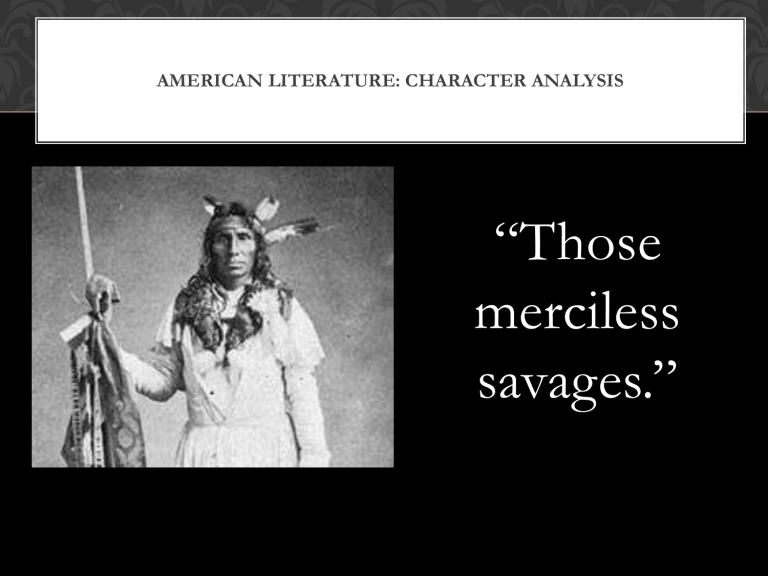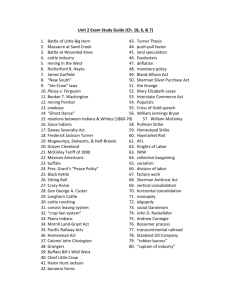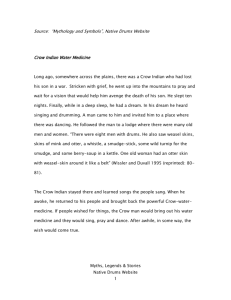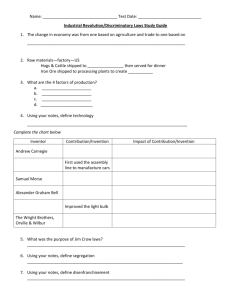character analysis - Wayzata Public Schools

AMERICAN LITERATURE: CHARACTER ANALYSIS
“Those merciless savages.”
CHARACTER ANALYSIS: REVIEW
From The Scarlet Letter
Potential criminal could be “an idle
and vagrant Indian, whom the white man’s firewater had made riotous about the streets, was to be driven with stripes into the shadow of the forest.”
Chillingworth’s original garb described as a “strange array of civilized and savage costume.”
Jailer saw Chillingworth as a physician who was “familiar with whatever the savage people could teach.”
CHARACTER ANALYSIS: REVIEW
“The Black Man that haunts the forest.”
The Devil in Christian teaching, but also a reference to Native Americans and their religious beliefs, which the Puritans regarded as witchcraft.
Chillingworth’s knowledge of plants as medicine was “Nature’s boon to the
untutored savage.”
During his Indian captivity, he had
“enlarged his medical attainments by joining in the incantations of the savage
priests; who were universally acknowledged to be powerful enchanters, often performing seemingly miraculous cures by their skill in the black art.”
AMERICAN LITERATURE: CHARACTER ANALYSIS
Wild were these painted
barbarians…
Pearl ran and looked the
wild Indian in the face…
A party of Indians in their savage finery…
AMERICAN LITERATURE: CHARACTER ANALYSIS
From “Goodman Brown”
“There may be a devilish
Indian behind every tree.”
“The whole forest was peopled with frightful
sounds – the creaking of the trees, the howling of wild beast, and the yell of
Indians.”
AMERICAN LITERATURE:
DOMINANT AMERICAN VALUES
Achievement and success: winning or succeeding indicates intrinsic worth
Activity and work: person’s worth is measured by how much and why he or she does
Moral orientation: drive to see things as right and wrong, good or bad; the winner of a contest is morally superior to the vanquished
Humanitarianism: desire to be helpful and kind
Efficiency and practicality: new, modern and better is preferable to old, standard and traditional
Emphasis on progress: change is preferred to remaining stagnant; a desire to ignore or minimize the past and look to the future
Drive for material comfort: a need to acquire and display things, which offer comfort, convenience and luxury; not just for personal pleasure but also status
Equality: all people are equal and should be treated alike regardless of differences.
AMERICAN LITERATURE:
DOMINANT AMERICAN VALUES
Freedom: all people should be allowed to pursue their own courses as long as they do not infringe on others.
External conformity: desire to belong and fit in with a group
Science: good if used to continue progress or material comfort; distrust of “pure” scientists
Nationalism and patriotism: unflinching belief in our country and unswerving dedication to our ideals
Democracy: belief that all are equal under the law; disavowal of authority of any one individual
Individual personality: belief that one can and should make it on his or her own: “self-made man” (and woman)
AMERICAN LITERATURE: SATIRE
Satire
A literary term often used to ridicule or make fun of people, institutions and ideas. Let’s look at two examples.
A frequent target is human vice or weakness, often with the intent of correcting or changing the subject of the satiric attack.
In “Indians Today, The Real and Unreal,” what is the author pursuing through satire?
The stereotypical images and treatment of Native Americans.
“Traditionally, we Indians have had a ‘plight.’”
“We often hear ‘give it back to the Indians’ when a gadget fails to work. It’s a terrible thing for a people to realize a society has set aside all non-working gadgets for their exclusive use.”
“Land where our fathers died, land of the Pilgrim’s pride…
Some of us broke out laughing when we realized that our fathers undoubtedly died trying to keep those Pilgrims from stealing our land.”
CHARACTER ANALYSIS
Methods of characterization
• Character’s appearance
• Character’s words
• Character’s actions
• Author’s direct words about the character
• Others’ words to or about the character
• How others treat the character
• How others think about the character
• The thoughts and fears of the character.
CHARACTER ANALYSIS
Other questions:
• What is the importance of the character to the story?
• When and where does the character live?
• What are the character’s strengths and weaknesses?
• What does the character do?
• What are some of the character’s qualities?
• Does the character develop or change as the story progresses?
• How are issues of gender, race, and social class important?
CHARACTER ANALYSIS
So how do we start organizing our thoughts and information?
We have already done that with our prewriting work.
That’s the character analysis packet.
CHARACTER ANALYSIS
So where do we start writing?
We can look at some of Little Crow’s predominant traits:
PRAGMATIC: He recognized that the Dakota had little chance of defeating the white army; tried to co-exist in both worlds; sought (often unsuccessfully) to cut the best deal for the Dakota in land negotiations; attended missionary schools to sharpen math and English skills.
BRAVE/LEADER: “I am not afraid of death”; “dignified, determined, and ambitious”; to settlers and U.S. Army he emerged as a “fearsome leader”; didn’t skirt responsibility for the war.
PRIDEFUL: Taunt of being a coward pushed him toward his destiny; replaced by
Traveling Hail, “Little Crow was stung by the defeat.”
CHARACTER ANALYSIS
What else do we know about Little Crow?
• His mother recognized his greatness when he was born.
• He took pride in his heritage and native customs: He maintained native speech and attended functions
“dressed in beautifully beaded trousers, a silk shirt, and red belt and neckerchief.”
• Described as “dignified, very determined, and ambitious.”
• Was a womanizer and gambler in his young adulthood.
• He did not want to get “caught and hung,” but he also did not skirt responsibility for the war.
CHARACTER ANALYSIS
•
Now, we ask: Do these character traits line up with the stereotypes? Is here merely:
•
A “savage”?
•
A “noble warrior”?
•
A “spiritual person”?
•
A “drunken Indian”?
CHARACTER ANALYSIS
How do we start formulating this portrait?
A good attention-getter is always a good strategy:
A murdering savage or a people’s savior. Depending on different historical perspectives, Chief Little Crow can seen as both, neither, or someone in between. However, it’s clear that Minnesota’s most famous Native American leader is more than the Indian of Hollywood lore or the mythical figure of
Dakota legend. He is a complex man whose ambition, leadership and flaws force a contemporary reexamination of Native American stereotypes.
CHARACTER ANALYSIS
Notice what we have done here right away:
• We have identified Little Crow.
• We have established the controlling purpose: that this is going to be a paper discussing Little Crow and stereotypes.
• We have introduced three general points/characteristics that will help address both of those discussion points: ambition, leadership, and flaws.
CHARACTER ANALYSIS
Now, we build on the introduction with specific details in paragraph 2:
Little Crow is arguably the most compelling figure in the 1862 war between Minnesota Dakota and the U.S. Army. He was a reluctant leader whose pragmatic outlook on his people’s prospects in the battle did not prevent him from engaging in the bloodiest battles in U.S.-Dakota war history, according to Star
Tribune writer Curt Brown in his six-part series “A Man Lost in History.”
Let’s stop here to see what we have accomplished.
• We have put Little Crow in his time period.
• We have included a critical component of the series: that this takes place in Minnesota and is one of the historically worst battles.
• We have also identified the author of the series (Curt Brown).
CHARACTER ANALYSIS
Refer to the packet this way:
A six-part series titled “A Man Lost in
History,” written in 2012 by Minneapolis Star
Tribune writer Curt Brown.
Then your in-text citations should refer to the specific articles in the series.
CHARACTER ANALYSIS
Let’s continue:
Estimates put the eventual toll of soldiers and settlers at
600, many buried where they fell in unmarked graves. As Brown notes, if the same percentage of Minnesota’s population were killed today, 15,000 people would be dead. Little Crow believed there was great honor in his soldiers fighting U.S. soldiers and his warriors were responsible for horrific attacks on settlers, according to Brown.
Yet, Little Crow is hardly the stereotypical “savage” Native
American portrayed in Hollywood films.
CHARACTER ANALYSIS
What have we accomplished? We have set up the contrast that will drive the paper:
• He was a fearsome warrior who participated in some bloody warfare.
• Yet, we now can add some balance to that portrait, which will help offset the stereotype:
• He remained unconvinced that war was the Dakota’s best option.
• He was furious that his warriors had scattered and targeted immigrant families.
• He was not motivated by bloodlust alone: He (and the Dakota) were responding to years of broken promises, insults, and the horrific reality of watching their children starve to death on the reservations.
CHARACTER ANALYSIS
Establishing the other important source of information: “Reel Injun.”
Cite it as:
The 2009 Neil Diamond film documentary,
“Reel Injun” examines Hollywood’s depiction of Native Americans through a century of cinema.
CHARACTER ANALYSIS
Now, we establish more constrasts in the paper, pointing out that:
While an inspirational leader, Little Crow was also ambitious, and in his younger years, was a womanizer and gambler.
While remaining true to his native customs and heritage, he also adopted white ways, including education, religion and culture.
While looked at by many as a fearsome and shrewd leader, he was also criticized by his own people for negotiating dubious land deals that hurt the Dakota long term.
So, what should emerge is a portrait of a man who counteracts the stereotypes in both good and bad ways.
CHARACTER ANALYSIS
Reminders:
• Write in present tense.
• Write in third person (this includes avoiding second-person “you” when possible).
• Double-space throughout.
• 12-point type.
• About 2 ½ to 3 pages ought to do it, but that’s just a guideline.
• Format in MLA style
CHARACTER ANALYSIS
Your last name 1
Your first and last name
American Literature
Mr. Johnston
4 March 2013
TITLE IS CENTERED
Every page after that will have your last name and the page number in the upper right hand corner.




